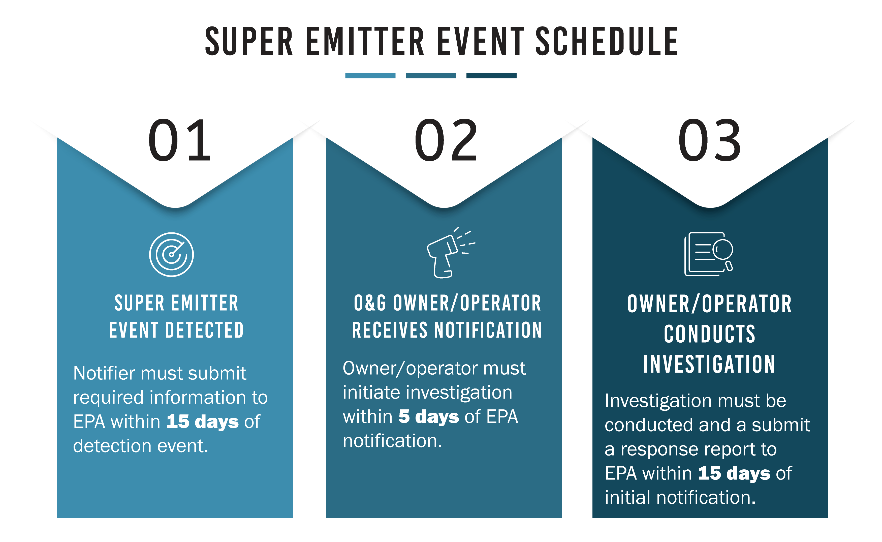EPA’s Super Emitter Program
The Environmental Protection Agency (EPA) published the final rule for New Source Performance Standards (NSPS) OOOOb and OOOOc on March 8, 2024. In the final rule, EPA includes a new Super Emitter Program. This program was developed in response to recent studies revealing that a small fraction of sources are responsible for nearly half of the methane emissions in the oil and gas industry.
Under the Super Emitter Program, local regulatory agencies and EPA-certified third parties must submit notifications to EPA when they detect super emitter events, defined as emissions of 100 kilograms of methane per hour or greater, at or near an owner’s or operator’s facility.
To obtain information on super emitter events from regulated and unregulated oil and gas sources, the Super Emitter Program requires all sources, regardless of whether they are regulated under CAA Section 111, to investigate events and report the findings back to EPA. This means that any oil and gas facility emitting methane could potentially fall under the Super Emitter Program, not just those subject to the various “Quads” (OOOO, OOOOa, OOOOb, or OOOOc).
Super Emitter Third-Party Notifiers
Contractors or NGOs who wish to become third-party notifiers under this program must be certified by EPA and demonstrate technical proficiency in one of three designated remote detection methods: satellite, aerial sensing equipment (including drones, fixed-wing aircraft, and helicopters), and mobile monitoring platforms (such as ground-based vehicles). The program does not permit third parties to access well sites or other oil and gas facilities, nor does it allow for the use of technologies like optical gas imaging (OGI), which would necessitate close access to such facilities. Applicants seeking certification will need to provide details regarding the experience and training of the notifiers, the remote detection technologies employed, and the established operating procedures and protocols for reviewing detection data as part of the certification process.
EPA is still setting up the registration system for parties to obtain certification. Trihydro anticipates that notifications for super-emitters will likely not happen before the latter part of the second quarter of 2024.
Super Emitter Event Investigation and Reporting
An owner or operator must launch an investigation into the super-emitter event within 5 calendar days of receiving the notice from EPA and submit a report of its investigation to EPA within 15 calendar days of the notification. Given the short timelines to respond, a prompt and thorough investigation can become critical following the identification of a super-emitter event. Operators should consider developing plans for how they will respond to super emitter events, as well as notifications of such events. These plans may include identifying who will lead any response to an EPA notification and the steps expected to be taken.

Both third-party notifications and reports from owners and operators conducting investigations will be submitted through EPA's publicly accessible Super Emitter Program Portal. Initially, EPA will publish authenticated notifications without attributing them to specific owners or operators. This approach allows the party to respond before the super emitter event is publicly associated with them, potentially incorrectly. However, if ownership or operatorship is later confirmed through a response from the owner or operator, or if no response is forthcoming and EPA views an attribution as accurate, EPA will subsequently make the information public.
Methane Waste Emission Charge and Subpart W
The Super Emitter Program also has synergistic impacts with other rulemakings. The proposed Methane Waste Emission Charge (WEC) rule will charge operators for methane emissions, as reported under Subpart W, that exceed waste emissions thresholds. The WEC starts at $900 per metric ton for 2024 reported methane emissions, increasing to $1,200 per metric ton for 2025 emissions and $1,500 per metric ton for emissions years 2026 and later. Promptly responding to and addressing the issues behind a potential super emitter event may save the affected operator thousands of dollars in WEC charges.
Operators can also use continuous monitoring systems to provide more accurate emission volume and duration data than EPA would have available. For instance, an operator adhering to periodic screening according to NSPS OOOOb may unknowingly exceed the super emitter threshold for weeks due to fugitive emissions on-site. Upon receiving third-party notification of a leak, operators must respond as previously described. In proposed changes to Subpart W, if the event duration cannot be determined, a default duration of 182 days must be assumed. An assumption of this magnitude could potentially trigger mandatory GHG Subpart W reporting for facilities previously viewed as exempt, in addition to the WEC charges described above.
Questions? Connect with Our Air Compliance Specialists.
Trihydro’s air quality and regulatory specialists remain current on changing regulations to support you in maintaining compliant operations and reporting. We can help you set up a notification response program, conduct proactive monitoring, and assist in understanding the overall implications of NSPS OOOOb compliance and Waste Emission Charge implications. Connect with us if you would like to discuss how EPA’s Super Emitter Program affects your facility.
